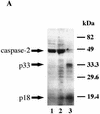Defects in regulation of apoptosis in caspase-2-deficient mice
- PMID: 9573047
- PMCID: PMC316779
- DOI: 10.1101/gad.12.9.1304
Defects in regulation of apoptosis in caspase-2-deficient mice
Abstract
During embryonic development, a large number of cells die naturally to shape the new organism. Members of the caspase family of proteases are essential intracellular death effectors. Herein, we generated caspase-2-deficient mice to evaluate the requirement for this enzyme in various paradigms of apoptosis. Excess numbers of germ cells were endowed in ovaries of mutant mice and the oocytes were found to be resistant to cell death following exposure to chemotherapeutic drugs. Apoptosis mediated by granzyme B and perforin was defective in caspase-2-deficient B lymphoblasts. In contrast, cell death of motor neurons during development was accelerated in caspase-2-deficient mice. In addition, caspase-2-deficient sympathetic neurons underwent apoptosis more effectively than wild-type neurons when deprived of NGF. Thus, caspase-2 acts both as a positive and negative cell death effector, depending upon cell lineage and stage of development.
Figures














Similar articles
-
Real-time detection of CTL function reveals distinct patterns of caspase activation mediated by Fas versus granzyme B.J Immunol. 2014 Jul 15;193(2):519-28. doi: 10.4049/jimmunol.1301668. Epub 2014 Jun 13. J Immunol. 2014. PMID: 24928990 Free PMC article.
-
Cytotoxic T-cell-derived granzyme B activates the apoptotic protease ICE-LAP3.Curr Biol. 1996 Jul 1;6(7):897-9. doi: 10.1016/s0960-9822(02)00614-0. Curr Biol. 1996. PMID: 8805307
-
Granzyme B-mediated death of pancreatic beta-cells requires the proapoptotic BH3-only molecule bid.Diabetes. 2006 Aug;55(8):2212-9. doi: 10.2337/db06-0129. Diabetes. 2006. PMID: 16873683
-
Signaling of cell death and cell survival following focal cerebral ischemia: life and death struggle in the penumbra.J Neuropathol Exp Neurol. 2003 Apr;62(4):329-39. doi: 10.1093/jnen/62.4.329. J Neuropathol Exp Neurol. 2003. PMID: 12722825 Review.
-
Perforin-dependent nuclear targeting of granzymes: A central role in the nuclear events of granule-exocytosis-mediated apoptosis?Immunol Cell Biol. 1999 Jun;77(3):206-15. doi: 10.1046/j.1440-1711.1999.00817.x. Immunol Cell Biol. 1999. PMID: 10361252 Review.
Cited by
-
Caspase functions in cell death and disease.Cold Spring Harb Perspect Biol. 2013 Apr 1;5(4):a008656. doi: 10.1101/cshperspect.a008656. Cold Spring Harb Perspect Biol. 2013. PMID: 23545416 Free PMC article. Review.
-
The developmental origins of the mammalian ovarian reserve.Development. 2015 Aug 1;142(15):2554-63. doi: 10.1242/dev.125211. Development. 2015. PMID: 26243868 Free PMC article. Review.
-
Metabolic Regulation of Apoptosis in Cancer.Int Rev Cell Mol Biol. 2016;327:43-87. doi: 10.1016/bs.ircmb.2016.06.006. Epub 2016 Jul 30. Int Rev Cell Mol Biol. 2016. PMID: 27692180 Free PMC article. Review.
-
Caspase-2 is essential for c-Jun transcriptional activation and Bim induction in neuron death.Biochem J. 2013 Oct 1;455(1):15-25. doi: 10.1042/BJ20130556. Biochem J. 2013. PMID: 23815625 Free PMC article.
-
Impaired antioxidant defence and accumulation of oxidative stress in caspase-2-deficient mice.Cell Death Differ. 2012 Aug;19(8):1370-80. doi: 10.1038/cdd.2012.13. Epub 2012 Feb 17. Cell Death Differ. 2012. PMID: 22343713 Free PMC article.
References
-
- Ashwell KW, Watson CRR. The development of facial motoneurons in the mouse: Neuronal death and the innervation of the facial muscle cells. J Embryol Exp Morphol. 1983;77:117–141. - PubMed
-
- Chinnaiyan AM, Dixit VM. The cell-death machine. Curr Biol. 1996;6:555–562. - PubMed
-
- Darmon AJ, Nicholson DW, Bleackley RC. Activation of the apoptotic protease CPP32 by cytotoxic T-cell-derived granzyme B. Nature. 1995;377:446–448. - PubMed
Publication types
MeSH terms
Substances
Grants and funding
LinkOut - more resources
Full Text Sources
Other Literature Sources
Molecular Biology Databases
